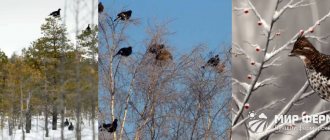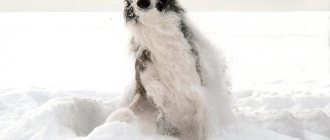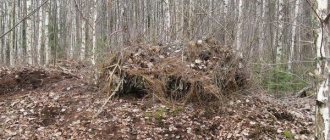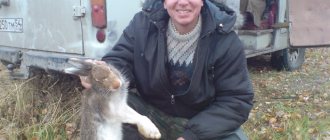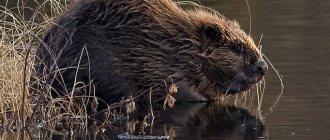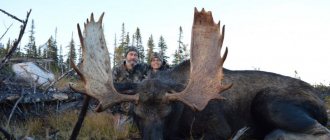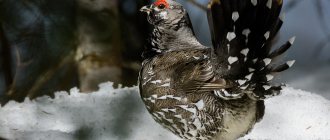About roe deer
The roe deer is the smallest representative of the deer family. The roe deer grows to a height of 75-85 cm, with a body length of 170-180 cm and an average weight of 25-30 kg.
Roe deer have poor eyesight, but their hearing and sense of smell are very well developed. A frightened roe deer can reach speeds of up to 65 km/h, while making jumps up to 10 meters long.
Roe deer have red fur in summer and grey-red in winter.
There are two types of roe deer in Russia: European and Siberian roe deer. The two types of roe deer do not differ from each other in the color of their fur, but the Siberian roe deer is much larger. A male Siberian roe deer is almost twice as large, its weight can reach 60 kg.
Roe deer: brief description
There are two large species of roe deer:
- East Siberian roe deer;
- Western European roe deer.
The coloring of the skins is virtually identical, but Siberian roe deer gain more body weight and weigh up to 60 kilograms. It grows up to 80 cm in height, and can reach 170 cm in length. Movement speed reaches up to 65 km/h. If they are pursued by danger, roe deer can make huge long jumps, reaching 10 meters in length.
In summer the skin is red in color, but by winter it turns noticeably grey. Roe deer prefer to live in deciduous forests with good undergrowth so that they can hide from view or in river valleys. But if there is a field with growing clover nearby, then there is no doubt that these graceful animals live there, since clover is their favorite food. They also use young shoots of trees and lichens as food.
This animal lives in the central part of Russia, Siberia and the Far East.
Breeding begins in early summer, and the male quickly identifies a female who is in heat. Since this lasts no longer than five days, during this time the male must find and catch up with the female for mating. The temporarily formed pair mates and after a certain time a calf appears. He is born disproportionately long-legged and helpless, weighing no more than 2 kg.
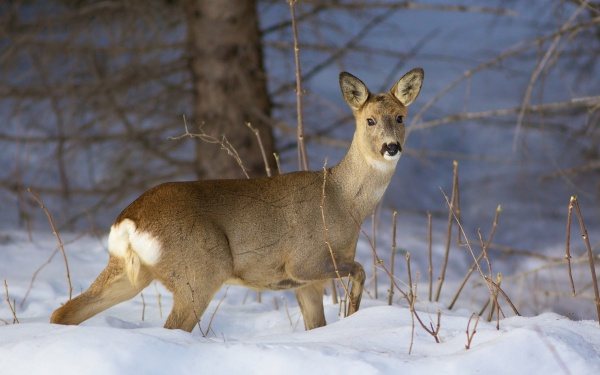
Where do roe deer live?
Roe deer live in deciduous and coniferous forests, often found in river valleys and reed thickets growing along the banks of reservoirs.
In forests, roe deer are most often found in open forests, in large forest clearings and meadows adjacent to the forest.
Roe deer feed before sunrise and after sunset. The rest of the time they spend in bedding areas, and in winter and summer roe deer lie down in different places. In summer, a typical bedding area is bushes or tall grass; in winter, a bedding area is a hole dug in the snow, in a place sheltered from the wind.
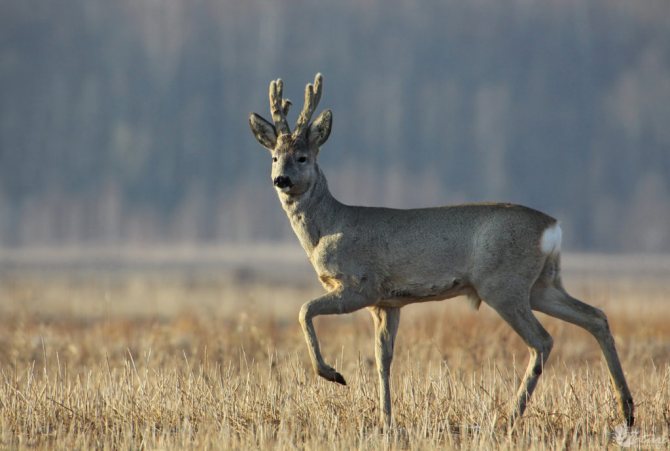
The main food of roe deer in summer is various herbs; they love to eat juicy berries and fruits. Roe deer willingly visit fields sown with clover. Roe deer need running water for drinking several times a day, so they often stay near small rivers, forest streams and springs.
In winter, it is much more difficult for roe deer to find food; they spend most of the short winter day in search of food. In winter, roe deer feed on acorns, moss, dry grass, shoots and buds of trees and shrubs found under the snow.
Brief description of the roe deer
The roe deer belongs to the artiodactyl deer family and lives in forest-steppe areas, subtaiga areas and in the taiga itself. Externally, the animals look like small deer; females do not have antlers, while males have small, double-branched, widely spaced antlers. The tail is short, the fur in the tail area is white. The color of the animal changes from red in summer to brown in winter. There are two types of roe deer - European and Siberian, the main difference being their size. The European one is noticeably smaller than the Siberian one.
Roe deer are a valuable hunting animal, their meat is high in calories, their skins are used to make suede, and their antlers are a valuable hunting trophy. In Siberia, roe deer are commercially exploited.
The animal's diet consists of plants, tree shoots, and buds. For proper growth, they need salt, which they extract from salt licks, or, if possible, drink water from mineral springs.
In summer, roe deer lead a solitary lifestyle; they gather in herds in winter . Their daily routine also depends on the time of year and habitat: in summer they are active at night and at dusk, in winter - mainly in the morning.
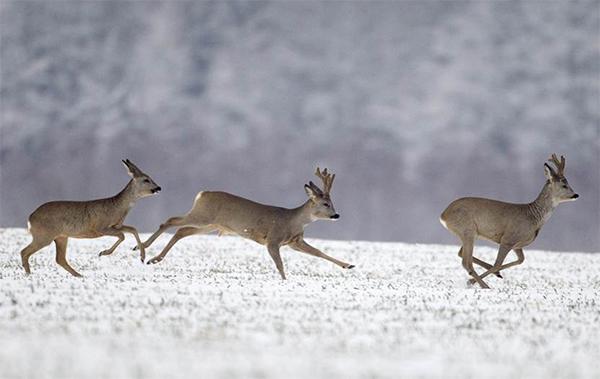
Hunting by seasons
The roe deer hunting season opens in the summer during the rutting period, which lasts from August 20 to September 20. All sexually mature groups begin to be hunted in the fall - from the beginning of October to the end of December. The exact timing of hunting for each species of roe deer is different in the regions; they are determined by separate regulations. Shooting is permitted only with a license.
Spring
In some regions of the country, a short hunting season for male roe deer opens in the spring; this hunt is carried out from May 20 to June 10. Hunting is carried out only for sexually mature males of European roe deer; female roe deer have already acquired offspring by this time, so hunting for them is prohibited. Spring hunting for male roe deer is very short and not very common.
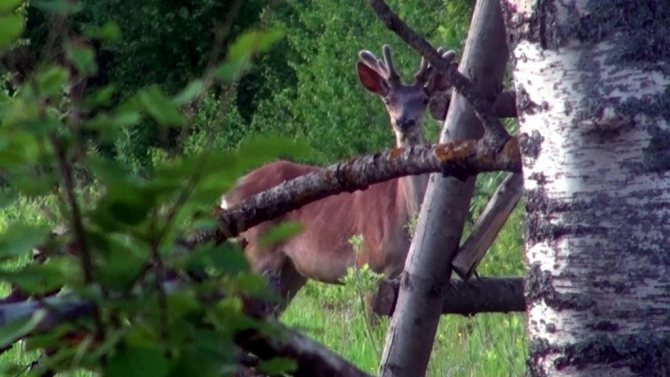
Summer
Summer is a unique period in roe deer hunting. In summer, hunting is carried out for male roe deer. Summer is the beginning of the period of roe deer hunting with decoy. At the end of summer, roe deer begin their mating season. At this time, females produce special odorous substances that have an intoxicating effect on males. At this time, male roe deer are in a state of rut, their behavior changes greatly, they become less cautious and more often go out into open spaces, where they are easier for the hunter to detect. The roe deer rut lasts approximately from August 20 to September 20.
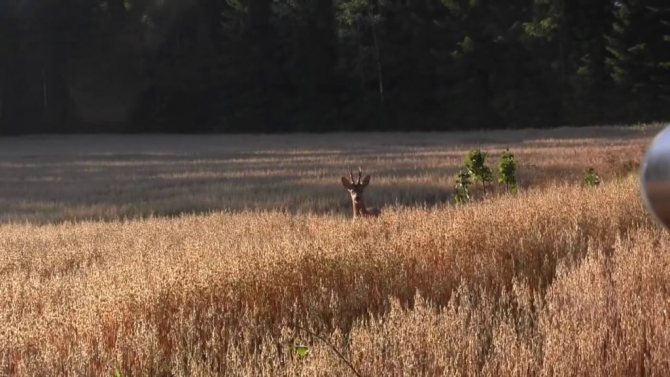
During the rutting season, a hunter can attract a male roe deer by making sounds with a decoy that imitate the voice of a female.
In summer, the roe deer has a red coat color, which only acquires a gray tint in winter.
The roe deer stays in deciduous and coniferous forests all year round, but in summer, when it’s hot, it prefers to stay in bushes, reeds and thick grass, near the banks of rivers and lakes. In such places, roe deer find both shelter from enemies and a watering hole. In summer, roe deer often go out to feed in fields with alfalfa and clover, so you can also look for them in such places.
Autumn
Autumn is the main time for hunting roe deer; at this time of year, hunting for roe deer is carried out in all permitted ways: with a decoy, a drive, from a tower, on salt licks and from the approach.
The mating period for roe deer, which begins in mid-summer, lasts until early October. During the rut, roe deer stay alone; at the end of the rut, male and female roe deer unite in herds and begin to move across the land from one place to another.
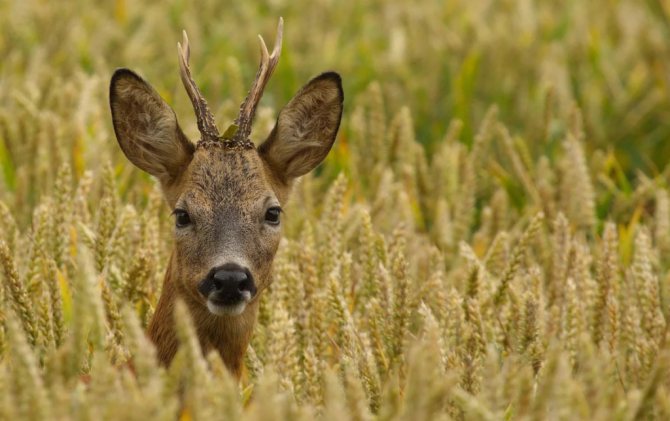
When the first snow falls, roe deer look for places with little snow where they can feed. Obstacles in the form of rivers and high passes make it difficult for roe deer to move, so in such places roe deer can accumulate in large numbers. Such places can be useful for organizing driven hunts for roe deer.
In autumn, it is best to hunt roe deer at dawn. Particularly suitable for hunting roe deer will be days with light rain and wind; on such days, intense drops form from the leaves of trees in the forest and roe deer enter from the forest into more open places where they are easier for the hunter to spot. Inclement weather dulls the hearing and sense of smell of roe deer, which makes it easier for the hunter to approach them within shooting distance.
Winter

Hunting for roe deer in winter does not differ in its methods from autumn hunting, and with snowfall some new ones are added:
- Due to snowfall, the amount of food available to roe deer decreases and they begin to more actively visit feeding areas where they are hunted from towers.
- In conditions of snowy winters, roe deer begin to move only along well-trodden paths; having studied such paths well, hunters arrange an ambush on one of them.
- Winter is a good time to conduct a driven hunt for roe deer; it makes sense to set up driven hunts only if there are a sufficient number of roe deer in the area.
- Winter allows you to hunt roe deer by following the trail. Such hunting is often carried out on freshly fallen snow, in snowfall, and under the sound of the wind, roe deer can allow the hunter to approach within 50-100 meters, which allows for a sure shot.
- In winter, approach hunting continues, hunting is carried out in roe deer feeding areas, and rifled weapons are often used for such hunting.
The ideal weather for roe deer hunting in winter is windy and clear. A cloudless sky makes it easier to find roe deer, and the wind muffles the hunter’s steps and hides his scent from the roe deer’s sensitive sense of smell. It is best to go to the roe deer hunting site at night, so as not to frighten them off if you accidentally meet them while moving to the hunting site.
Hunting an animal by season
Many novice hunters often wonder how to catch a roe deer and when is the best time to do it?
The summer hunting season for these animals begins during the rutting period: for European roe deer from approximately July 15 to August 15, and for male Siberian roe deer from August 25 to September 20. And in autumn and winter, hunters start hunting for all sexually mature individuals from the beginning of October to mid-January.
So, for example, the hunting season for European roe deer begins:
- Adult males can be hunted from July 15 to January 15;
- for other individuals - from October 10 to January 15.
As for the Siberian type, the hunt for them opens:
- for adult males - from August 25 to January 15;
- for other roe deer - from October 1 to January 15.
The exact timing for each type of catching this animal is different, depending on the region. They are established at the legislative level, by separate resolutions. You should always remember that you are allowed to shoot animals only if you have a special license to do so.
And for those who do not have a gun and a license, there are other ways to catch a roe deer without a gun. For example, using networks.
Roe deer hunting from the approach
Hunting for roe deer from the approach is the most difficult method of hunting this animal, accessible only to the most experienced hunters. The difficulty of hunting a roe deer from the approach lies in the fact that while tracking a roe deer, the hunter must come within shooting distance without unnecessary rustles and sounds. The hunter goes on such a hunt alone, less often together, sometimes they take a well-trained dog with them on such a hunt. A roe deer caught from the approach is the most honorable trophy for a hunter.
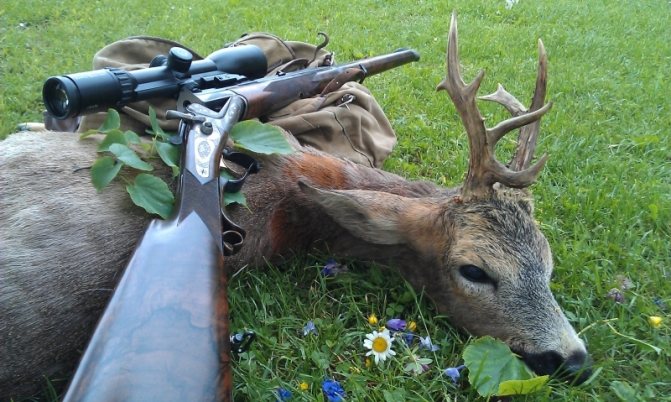
In order for roe deer hunting from the approach to be successful, certain rules must be followed:
- Hunting for roe deer from the approach begins with searching for places for such hunting. An experienced hunter uses the off-season to search for tracks and entire trails that roe deer leave in their lands. Particular attention is paid to searching for traces at crossings, in wet places, and on the banks of reservoirs. An experienced hunter should have several such explored roe deer habitats so that at any time, in any weather, he could choose a suitable place for hunting.
- Preliminary reconnaissance allows you to determine the location of roe deer in the area, bedding and feeding areas. Roe deer love to graze in open forests and forest clearings. The hunter, on the eve of the hunt, walks around such places, trying to see the tracks and paths of the roe deer, and if he is lucky, the roe deer itself.
- The direction and strength of the wind is the most important point when choosing a place and method of hunting roe deer; it is necessary to take this point into account when conducting a hunt.
- Good camouflage plays an important role when hunting roe deer. Clothes should not rustle when moving or in the wind; they should be made of soft fabric. The color of clothing should match the surrounding area: in summer and autumn, the best camouflage color is khaki; in late autumn and winter, camouflage should be grayish tones. It is best to wear shoes on your feet that will not create noise when moving, these can be short rubber boots, or ankle boots, or felt boots in winter.
- It is best to be at the hunting site an hour before sunrise, at which time the roe deer is already feeding, and after sunrise the roe deer goes into the thickets to wait out the rest of the day.
- If you arrive at the hunting grounds after sunrise, you will have to follow the tracks of the roe deer, trying to spot it lying down.
- Morning is the best time for hunting; during the day and evening, roe deer are much more careful.
- If there are disturbance factors, roe deer will come out into open places: meadows and clearings only at night.
- In winter, due to a lack of food, roe deer can go out in search of food during the day.
- Hunting for roe deer from the approach is often successful on days of prolonged bad weather, when there is a light drizzle or after it, a strong wind also helps the hunter. In such conditions, the hunter often manages to get close to the roe deer.
- When moving through the forest, be quiet, do not make unnecessary movements, do not talk, do not rustle, and do not smoke. You need to be especially careful when approaching intended feeding and bedding areas.
- When searching for roe deer, always move against the wind to prevent the roe deer from picking up your scent.
- When you find roe deer, approach them very slowly, silently, with frequent stops, use natural shelters: hide behind tree trunks and bushes.
- If the roe deer turn their heads in your direction and listen, freeze and do not move. The roe deer has a well-developed sense of smell and hearing, but poor vision. Chances are high that the roe deer will not notice you. If the roe deer have not noticed you, they will continue to feed with their heads bowed. If a roe deer notices you, the male makes a sound similar to a dog barking and runs away.
- The roe deer is a very cautious animal, sensing the slightest danger, the roe deer take off, developing speeds of up to 60 km/h and making jumps up to 7-8 meters long. Only a very experienced and successful hunter can approach them at a distance of 50 meters, so When hunting roe deer from the approach, it is recommended to use not a smoothbore gun, but a rifled weapon.
A little about roe deer
This animal is perhaps the smallest representative of deer. For example, a roe deer on average can grow up to 85 cm in height and up to 180 cm in length. And the average weight of this mammal can reach up to 30 kg.
These animals have very poor eyesight, but despite this, their sense of smell and hearing, on the contrary, are quite well developed. It is noteworthy that the frightened mammal can move at speeds of up to 65 km/h, and its jumps can reach up to 10 meters in height.
The fur of roe deer has an individual distinctive feature, for example, in summer they are reddish in color, and in winter they are gray-red.
There are two main types of roe deer in Russia:
- European;
- Siberian
Both the European and Siberian roe deer are almost identical in color. But the latter are slightly larger in size than their relatives. The male Siberian roe deer is much larger in size, approximately twice as large. And its weight can reach up to 60 kg.
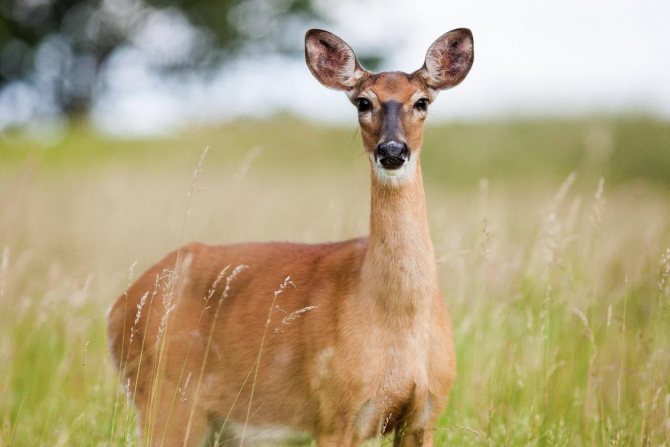
Hunting for roe deer by following the tracks
Hunting for roe deer by tracks is a type of hunting from the approach; it is carried out in winter, when the tracks of roe deer are clearly visible on freshly fallen snow.
The best time to hunt roe deer by following the tracks is considered to be early winter morning. The best weather for such a hunt: wind, light drizzle or snow powder.
The hunter must be able to understand the tracks of roe deer; deep footprints located at a great distance from each other mean that the roe deer was running away from danger. Shallow, even tracks located quite close to each other mean that the roe deer after feeding is looking for a place to lie down; the hunter must be ready. A hunter acquires the ability to read tracks with experience.

When following the tracks of a roe deer, you should not move directly along the path left by the roe deer; it is better to move in such a way as to cross the track of the tracks at an angle.
When approaching roe deer, you need to move absolutely silently and stop from time to time, while you can carefully inspect the nearest trees and bushes with binoculars. If, while approaching the roe deer, you suddenly make an unwanted sound, you should freeze for 15-20 minutes so as not to scare the roe deer.
Hunting for roe deer in winter is a more difficult process, since due to the lack of leaves on the trees, it is easier for the roe deer to notice the hunter. An experienced hunter, taking advantage of the whistling wind or snowfall, can approach a roe deer at a distance of 100-150 meters.
It is believed that approaching a lone roe deer is more difficult than approaching a herd of roe deer, since a single roe deer is especially careful.
A frightened roe deer, having run a certain distance, stops to assess the danger; this moment is convenient for firing a shot.
Hunting on the trail
This is a subspecies of running hunting. In this case, relying on your experience and skill, you can independently track down the prey. It must be borne in mind that these animals are very shy. They instantly react to any unexpected noise. At the same time, they can run away at high speed for 2-4 km. Having made an unwanted sound, you should freeze for 15-20 minutes so as not to scare off the individual. It is difficult to shoot a lonely animal, it is especially careful. Therefore, it is better to follow the trail of the herd.

Roe deer tracks in winter
For effective hunting when tracking a scent, you must have a special staff or shooting support with you. Without this handy tool, it will be difficult to hit an animal from a distance of 200 m.
But the roe deer has one peculiarity. Having run a certain distance, this animal will definitely stop to assess the danger. At this moment, the staff will come in handy for a quick aimed shot at the roe deer. The gun should always be kept alert when stalking prey.
When tracking two roe deer, keep in mind that, having killed one, you can safely follow in the footsteps of the other individual. Roe deer are loyal animals and will definitely wait for their relatives.
Hunting for roe deer in a pen
Hunting for roe deer in a drive is an organized collective way of hunting this animal. The best time for driven roe deer hunting is from mid-November to the end of December.
In order to organize a driven hunt for roe deer, you need to know well the places in the lands where roe deer live constantly. Before starting a hunt, it is advisable to check for the presence of roe deer in the forest area where you plan to make a pen; to do this, you need to first check the number of entrance and exit tracks.

Most often, up to 10 hunters take part in a driven hunt, who are divided among themselves into shooters and beaters. In order not to offend anyone, it is best to make several drives during the day, while the hunters can change roles, the one who was the shooter in the first drive becomes the beater and vice versa.
The ratio between the number of beaters and shooters changes throughout the year. In autumn and when hunting in dense forest thickets, the number of beaters is equal to the number of shooters. In winter and in open forests, the number of shooters is one and a half times greater than the number of beaters.
The hunt director determines the number of beaters and assigns shooters to numbers. At the same time, in his decision he is guided by the weather and terrain conditions. For safety reasons, beaters must wear bright, reflective clothing.
First, the shooters are placed on the numbers; this can be done on foot, on skis or using transport.
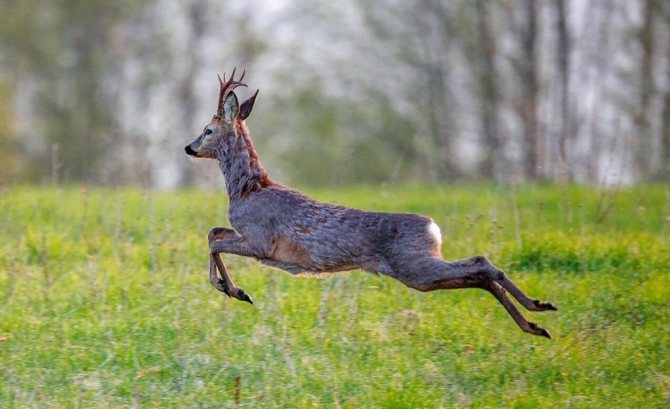
The arrows should be placed so that the wind blows from the paddock onto them. Most shooters during driven roe deer hunting are armed with smoothbore guns. Shooters with rifled weapons are placed on the flanks of the shooting line to prevent roe deer from bypassing the shooting line.
The shooter must stand on the number without hiding or moving. If the shooter does not move, the roe deer will not notice him and will approach at a close distance. It is strictly prohibited to make noise, talk or smoke in the room. It is advisable that the shooter can see the shooter on the adjacent shooting number. While on the number you need to be constantly ready to shoot. It is strictly prohibited to leave the room or change place before the end of the run.
After all the arrows are placed, the beaters, at the command of the hunt leader, begin to move. The line of beaters should move evenly, without overtaking, there should be no loud screams or unnecessary noise. The beaters can talk quietly, lightly tap tree trunks with sticks; if these conditions are met, the roe deer gradually enter the line of shooters, and the shooters have the opportunity to make successful shots.

If the beaters make too much noise, then the roe deer run at high speed from extreme fright, not clearing out the road in any direction.
Having discovered traces or the roe deer itself, the beater must inform neighboring beaters and the head of the hunt. It is convenient if all participants in the hunt can communicate with each other using walkie-talkies or, in extreme cases, by mobile phones.
The basis of safety during driven hunting is the strictest discipline, which all hunters must strictly observe.
Hunting an animal from the approach
Hunting for roe deer from the approach is the most difficult of all known and used methods of hunting this animal. It is available exclusively to professional hunters. The difficulty of this type of roe deer hunting from the approach is that while tracking a roe deer, the amateur hunter is obliged to come within shooting distance without any unnecessary rustles or sounds. An amateur hunter must go on this hunt alone, in some cases together, in rare cases you can take a specially trained dog with you. A roe deer caught from the approach is the most honorable trophy for a hunter.
Well, in order for hunting this animal from the approach to be successful, it is recommended to follow a number of certain rules.
Roe deer hunting rules
| First | Hunting for roe deer from the approach should begin by searching for suitable places for such hunting |
| Second | Such reconnaissance helps to determine the exact location of roe deer in the area, as well as their bedding and feeding areas. |
| Third | The strength and direction of the wind are the most important factors when choosing a place and method of hunting this animal, so it is very important to take this point into account during the hunt. |
| Fourth | Excellent camouflage plays a special role during roe deer hunting. |
| Fifth | Already at the hunting site you need to be an hour before sunrise, it is at this moment that the roe deer begin to feed, and after sunrise the animal goes into the thickets in order to lie down all day |
| Sixth | If a hunter arrives at the hunting grounds immediately after sunrise, he is recommended to follow the tracks of the animal, trying to find a roe deer lying down |
| Seventh | Morning is the right time for hunting; during the day and evening these animals are much more careful |
| Eighth | In the presence of various disturbance factors, animals go out into open places, such as meadows and clearings, exclusively at night |
| Ninth | In winter, due to insufficient food, roe deer can go out in search of food during the daytime. |
| Tenth | Hunting an animal from the approach is often successful on days of prolonged bad weather, when there is light rain or even after it, in addition, a strong wind also helps the hunter. In such conditions, the hunter quite often manages to get closer to this animal |
| Eleventh | When moving through the forest, you need to behave as quietly as possible, do not make any unnecessary body movements, do not talk, do not rustle, and do not smoke. |
| Twelfth | When searching for mammals, you should always move against the wind, this is necessary so that the roe deer do not smell the hunter |
| Thirteenth | When a mammal is spotted, it is recommended to approach it slowly, always silently, make frequent stops and be sure to use natural shelters: hide behind tree trunks and bushes |
| Fourteenth | If the animals turn their heads towards the hunter and listen, you need to freeze for a while and not move. These mammals have well-developed senses of smell and hearing, but they have very poor vision. |
| The fifteenth | The roe deer is a very cautious animal, therefore, as soon as it senses a slight danger, it takes off abruptly, developing speeds of up to 60 km/h and making jumps up to 7-8 meters long |

Hunting from the tower
Hunting for roe deer from a tower is most often carried out on specially constructed bait sites. Such bait sites are set up in organized hunting farms that have their own lands.
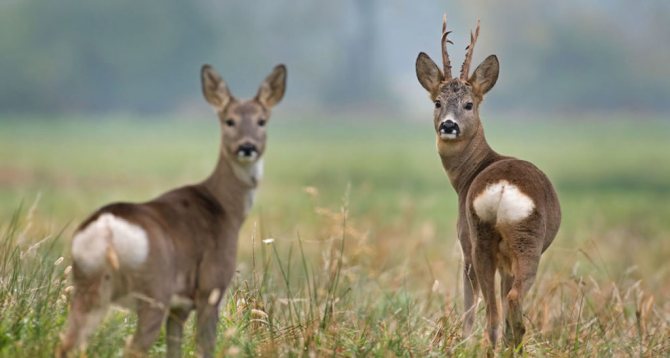
For the convenience of hunters, a hunting tower is installed next to the bait area. The structure of the tower must be strong, there must be comfortable seats inside the tower, and loopholes for shooting must be made in the walls of the tower. It is best if the hunting tower is made from locally available materials, then it will not be too conspicuous.
Roe deer get so used to the tower located near the feeding area that they are not afraid of it at all and perceive it as part of the surrounding landscape.
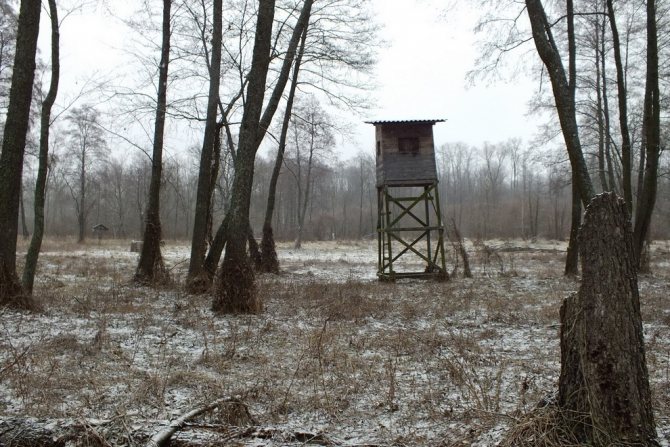
Sometimes towers for roe deer hunting are not installed at bait sites, but at the edge of the forest, at the edge of meadows or fields adjacent to the forest, at the edge. It is best if the tower is not installed at the very edge of the forest, in 2-3 rows of trees, then it stands out less against the background of the surrounding area.
The roe deer does not see or smell the hunter who is on the tower, so it can approach at close range; the hunter can only fire a well-aimed shot.
Hunting from a tower is most often carried out at dusk or at night; moonlit nights are very suitable for this. The rest of the time, the hunter has to use either an under-barrel flashlight or a night vision scope, but their use must be permitted by the hunting regulations of the region in which you are hunting.
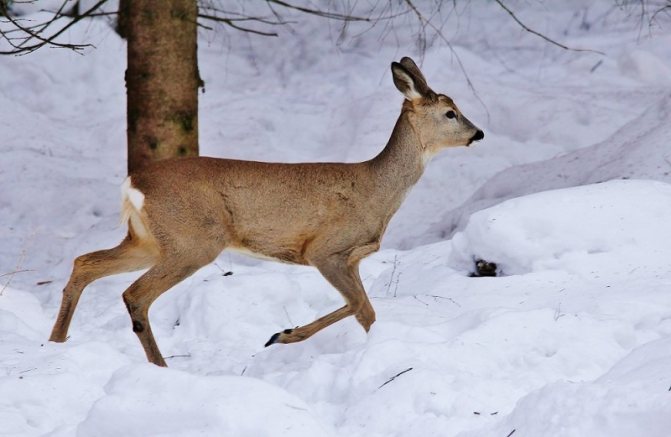
Hunting from a tower is considered the easiest way to hunt roe deer. This method of hunting may be of interest to novice hunters, as well as those hunters who, due to age or health, cannot afford serious physical activity.
Hunting with a dog
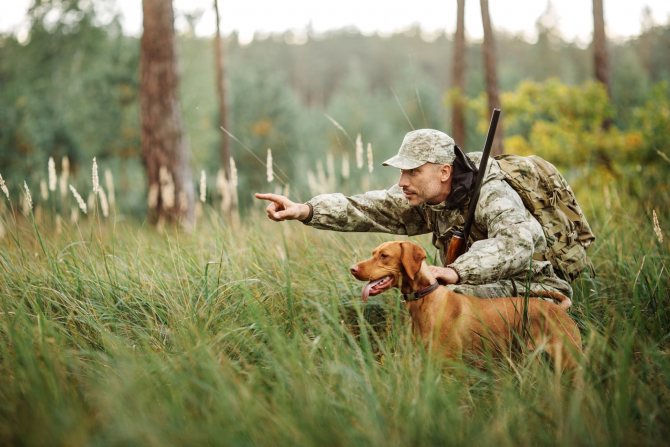
Hunting with hounds or dogs of other breeds is not the best choice for a hunter who wants to catch a roe deer. This animal is very timid and can develop great speed. Only a hound can catch a roe deer, but these dogs develop too much speed, making the animal feel in danger. As a result, the roe deer begins to try to escape from the pursuer by jumping, which prevents the hunter from taking aim.
For such a hunt, you can choose only calm hounds who will not immediately drive the prey, but will advance slowly but steadily. In this case, the roe deer will not show much anxiety, feeling that it can break away from the pursuer at any moment. The hunter’s task is to approach from the other side in time, before the dog starts chasing the roe deer.
Dogs can be used to collect wounded animals, but here it is necessary to take into account that a roe deer loses little blood, like any small animal, so a dog with exceptional sense is needed.
Hunting from ambush
Roe deer hunting from ambush is most often organized on paths made by roe deer in a winter snow-covered forest. It is neither possible nor necessary to build a tower in such a place; it is quite possible to get by with a small ambush.
Roe deer ambush hunting begins with searching for ambush sites. Such a place should be visited by roe deer on an ongoing basis. The ambush is made on the path along which the roe deer move from feeding areas to bedding areas.
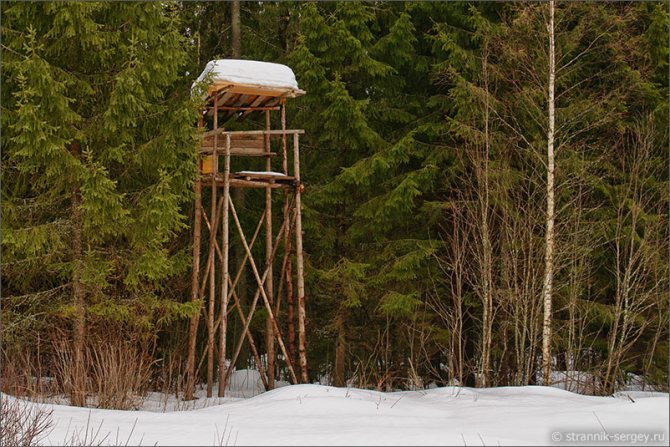
Hunting for roe deer from ambush is much more difficult than hunting from a tower. The hunter has to wait for the roe deer for a long time and most often in subzero temperatures.
The hideout can be arranged either on a tree or on the ground. The shelter should fit perfectly into the surrounding area and not stand out against its background. It is best if it is made from locally available materials.
The main difficulty of hunting roe deer from ambush is that roe deer, thanks to their well-developed sense of smell, are able to smell the scent of a hunter in ambush from a great distance.
Hunting for roe deer from ambush
Ambush hunting involves two methods of ambush: a self-equipped shelter or a special tower. Ambushes are mainly made at places where artiodactyls appear. For example, these could be paths that are very clearly visible in the snow. When hunting is organized through towers, special bait areas are created. The towers have been standing for many years, so the roe deer get used to them and do not feel threatened. This method of hunting is considered the most common, since artiodactyls, without feeling danger, approach the tower within the distance of a killing and aimed shot. Hunting for roe deer from a stand built independently is more difficult. Since, first of all, you need to decide on the place where roe deer are most often found and then wait for the appearance of game. The ambush must be similar to the environment and not arouse suspicion in the wild animal.
Roe deer, due to their good sense of smell, can easily hear the smell of a person, so foreign odors should not be present
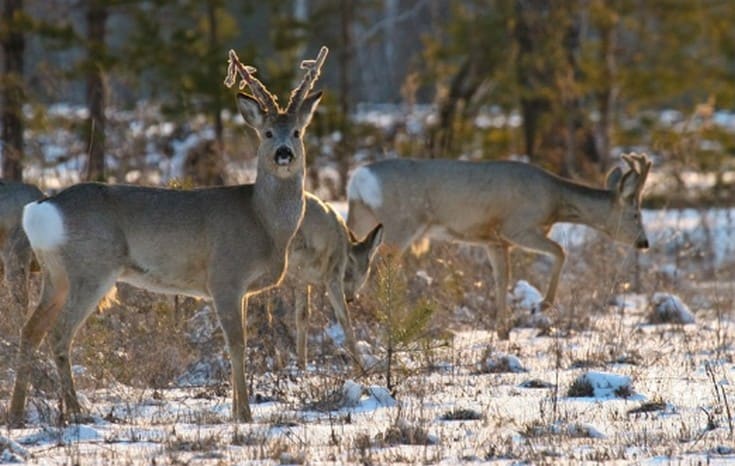
Hunting for roe deer on salt licks
Hunting for roe deer on salt licks is a variation of the method of hunting roe deer from ambush. Roe deer, like other ungulates, experience a lack of salt. Hunters set up artificial feeders with salt in suitable places. Not far from the salt lick, a storage shed or shelter is set up.

Roe deer most regularly visit salt licks in the summer; this is the best time for hunting in salt licks; it is in the summer that roe deer experience the maximum need for salt. A salt feeder is made from fallen aspen, in the upper part of which a crack is cut out with an ax into which salt is poured. Another option for making a salt feeder is to make it from an aspen log, which is placed on two stumps and salt is poured on top. The salt feeder should be comfortable for roe deer so that they can lick the salt in a natural position for them and at the same time have the opportunity to inspect the area around them. Roe deer love to visit salt licks located near watering places and feeding areas.
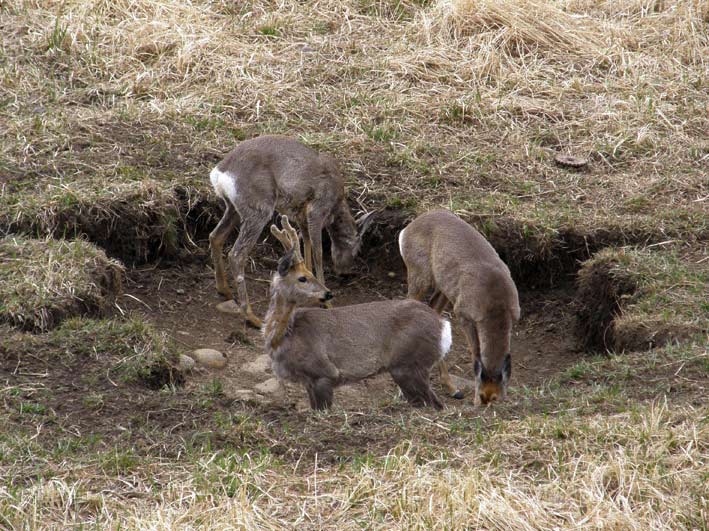
Not far from the salt lick, blind spots are set up; most often there are at least two of them, so that you can choose one of them, taking into account the direction of the wind on the day of the hunt. The blinds are made on trees with a dense crown so that the roe deer cannot see the hunter. The blind should be located at a height of 3-4 meters from the surface of the earth, then the roe deer will not be able to smell the hunter, in addition, the hunter will be able to see the roe deer from a greater distance.
Hunting on salt licks
Hunting in salt licks begins in spring and ends with severe winter frosts. Its essence lies in the fact that ungulates need a large amount of minerals to strengthen bones and grow new horns.
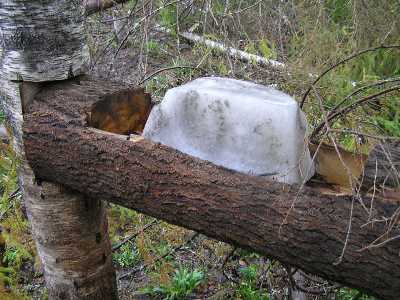
This is what many hunters take advantage of, making artificial salt licks and luring animals there. To build an artificial salt lick, you can use any salt, but, as a rule, hunters use stone salt. When placing salt licks, you should follow several rules:
- It is recommended to install salt licks near a water source;
- when placing solonetz, the factor of production transportation should be taken into account;
- the storage shed for shooting must be placed in the direction from which the wind most often blows, so that the animal does not smell it;
- It is most effective to hunt on salt licks in the evening.
Hunting with decoy
Hunting for roe deer with a decoy is the most interesting way of hunting for roe deer, which is used by hunters with extensive experience in hunting ungulates.
The hunter scouts in advance the places where a fairly large number of roe deer live. It is best to start hunting early in the morning. The hunter walks around the places where roe deer are supposed to live and makes stops to lure the roe deer with a decoy. When luring a roe deer with a decoy, you should not immediately lure with loud sounds, you need to start luring with quieter sounds, gradually increase the volume. It is better to repeat alluring sounds at intervals of 10-15 minutes. A pause in the lure is needed to give the roe deer time to approach the hunter and not scare them away. If the roe deer do not appear, you need to change the place and continue attracting there.

Roe deer hunting with a decoy is especially effective during the roe deer rut. This period lasts from July to the end of August. Rutting areas can be determined by the traces that males leave on the ground in the process of pursuing a female: ruts, trampled circles and areas. In the first half of the rut, you need to use the voice of a young female, in the second half, towards the end of August, you need to attract roe deer with the voice of an old female. At the beginning of the rut, hunting is less effective, but as most females are fertilized, male roe deer are more and more willing to follow the sound of a decoy and by the end of the rut, hunting becomes more and more effective. Young male roe deer are especially active in responding to the sound of a decoy; more experienced males behave more cautiously and are not so easy to deceive. Sometimes the female roe deer first approaches the sound of the decoy, and only then the male comes running after her.
Hunting for roe deer with a decoy can be carried out not only during the roe deer rut, but throughout the year, although it will not be as effective. Roe deer use various sounds for communication all year round: females whistle to call their calves, hungry cubs call their mother to feed them, roe deer have special sounds with which they notify their herd of danger. A hunter can imitate the sounds of roe deer using a decoy in order to lure them within shooting range. When hunting roe deer with a decoy, it is advisable to use a high-quality purchased decoy, although some hunters with extensive hunting experience make such decoys themselves, and homemade decoys made by an understanding craftsman are not inferior in sound quality to purchased decoys.
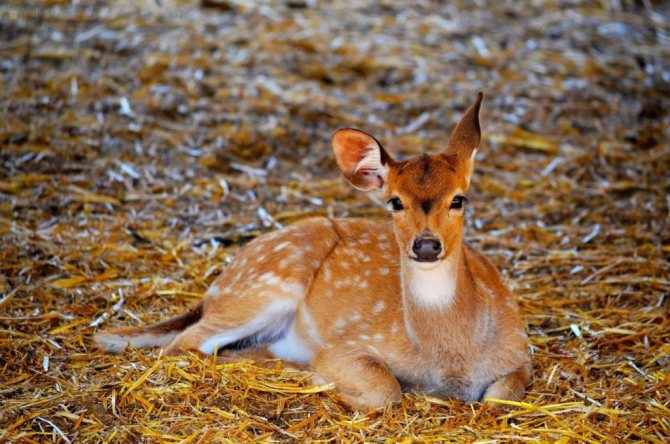
The only way to learn how to properly attract roe deer with a decoy is practice. The hunter finds roe deer grazing and begins to attract them with a decoy. Then, based on the behavior of the roe deer, he determines whether he is doing everything correctly: if the roe deer are hiding, then he is doing something wrong, and if the roe deer remain in place and begin to come closer to the hunter, then the hunter is doing everything correctly. By constantly practicing how to attract roe deer, the hunter will soon be able to become a real professional.
Weapons and ammunition for roe deer
Mostly rifled weapons are now used when hunting roe deer. According to the law, it must have a caliber of at least 5 millimeters, there is no upper limit. Therefore, among the recommendations you can find both carbines for .222 Rem and 9.3x72. Although hunting practice shows that when hit “on the spot” at distances of up to 200 meters by “three deuces”, the average run of a roe deer does not exceed 30 meters. In this case, tissue damage remains minimal. True, the bullet hole closes up quite quickly, which is not conducive to finding a wounded animal if something like this happens.
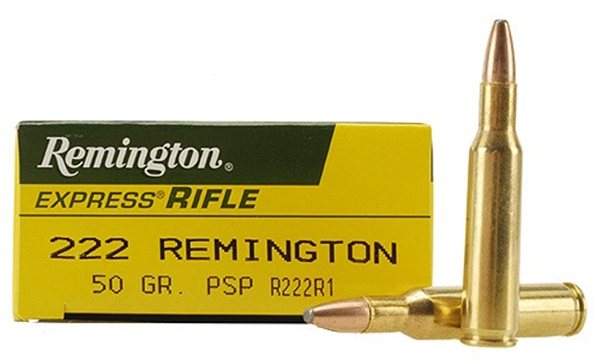
Universal calibers - derivatives of the 30th - for roe deer are highly effective in the vast majority of cases. Especially with semi-jacketed bullets. All the larger ones - even more so. The latter, due to their not very flat trajectory, are not very suitable for a running animal, but this is not our case.
The restriction on such cartridges when hunting roe deer in most countries of “old Europe” looks rather strange. And the beloved domestic 7.62x39 is generally ostracized. But this is only at first glance. This approach is associated with a very careful attitude towards traditions, which leads to the rejection of rifled semi-automatic machines in general. The chatter, and only it, is the choice of a real hunter! As for the now widespread opinion that smooth-bore guns are unsuitable for stealth hunting, we, comrades, are a little bit fed up. Somehow, our fathers and grandfathers hunted with them not even for decades, but for hundreds of years. And many continue to do this now.
For ungulates, the law “strongly recommends” the use of only bullet cartridges with guns, allowing the use of buckshot specifically for roe deer, as well as fallow deer and musk deer.
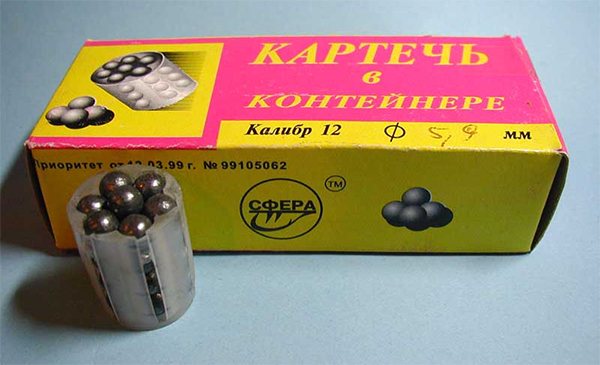
Sizes start from 5.8 mm, but the best option would be a matched 6.2 mm wolf. Although there are known cases, and quite a few, of the successful use of even the fraction “0000”. True, when hunting with a rifle, the distance of a confident shot will have to be greatly reduced. And this is only possible for an experienced hunter who can also move silently across any terrain. Especially in windless or, even worse, frosty weather.
Hunting for transitional roe deer
Hunting for transitional roe deer is common in Eastern Siberia, the Far East and Altai. A transitional roe deer is a roe deer that, with the onset of cold weather, migrates from one place to another in search of food. Roe deer can move alone and in small herds.
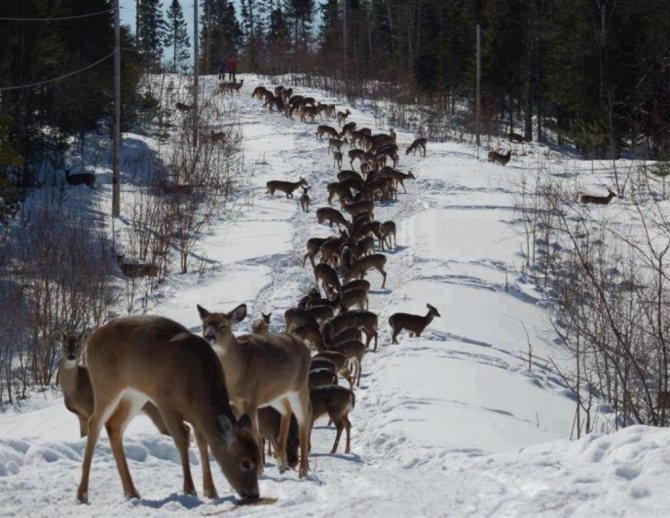
Moving from place to place, roe deer accumulate in large numbers near natural obstacles: rivers, passes, which they cannot immediately overcome. The hunter, knowing such places, sets up an ambush in them. The best time for such a hunt is late autumn, at this time, after snow has fallen, the roe deer leaves the summer feeding places where there is no food left, in search of new feeding places. In the spring, with the onset of warmth and snow melting, roe deer return to their original places.
Hunting for transitional roe deer can be very prey; previously this method of hunting was used for commercial hunting of roe deer, as a result of which the number of roe deer has greatly decreased.
Types of autumn roe deer hunts
From the very beginning of summer, the rut begins, which lasts until the end of autumn. Throughout this period, roe deer are ferocious and often beat each other to death. Males continue to pursue females until they are completely exhausted. As soon as the rut ends, large herds are created and a new period begins: the time of the autumn transition. Before the onset of autumn, they move alone, and then create small groups, among which there is always one suitable male.
First, let's remember what kind of habitat and what behavior is typical for them. In autumn they begin to regularly migrate from one place to another. If snow falls, they choose areas with little snow. Since passes and rivers do not allow roe deer to move further, they often stop near the named places. Wind and light rain are called excellent weather. There are several reasons for this:
Windy and rainy weather encourages the animal to go out into open areas. Inclement weather allows you to get close to individuals with a sensitive sense of smell and keen eyesight.
Corral method
Each hunter can be classified as a group of beaters or shooters. In the past, driven hunting was very popular and up to 50 hunters could take part in it. Nowadays, no more than 10 people gather for this. We recommend carrying out 3-4 drives in one day, constantly changing the roles of hunters so that everyone can be a shooter or a beater. Two aspects can help: the title of the territory, as well as an accurate understanding of behavior and habits. It's best to make noise when she starts to run away, it interferes with her concentration.
The senior person assigned to the group or hunting farm is responsible for the distribution of roles, giving someone the task of being in ambush (at the number), and others to be in the corral (beater). A well-chosen place will depend on knowledge of the area, relief and behavior of the animal. Therefore, most often a person representing the hunting area in which the hunt is conducted is appointed as the hunt leader.
After everyone has been assigned their numbers, hunters are strictly forbidden to leave their places, talk, smoke or make noise. The basic criteria for a room must be met: the ability to camouflage with the terrain, have excellent visibility, visibility of neighboring rooms and the direction of the wind - it must blow towards you.
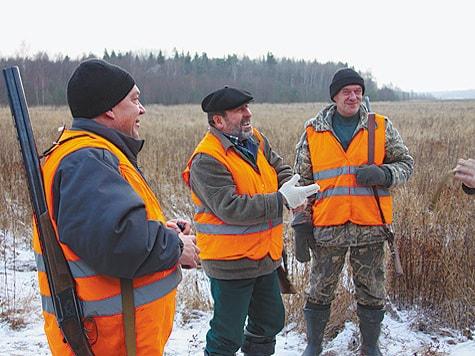
Group of beaters before the hunt
After all the shooters have been assigned numbers, the beaters begin to move. They move noisily, talking to each other, making loud cries, and hitting tree trunks with sticks. At the same time, they are dressed in a bright orange uniform, for visibility. The main task is to raise the animal and direct it to the line of fire, into an ambush.
The video below shows a successful run.
Hunting for roe deer by stealth (from the approach)
If you aim for a successful outcome, then the method is suitable for experienced hunters. It is necessary to be well oriented in the location of the event, to clearly know the feeding and bedding areas of the animal.
A beginner should start by looking for traces. Next, use them to determine the direction of movement of the roe deer and their numbers. In this way, it is possible to determine the approximate habitat, feeding and resting areas of the animal.
Roe deer tracks depending on the ground and speed of movement
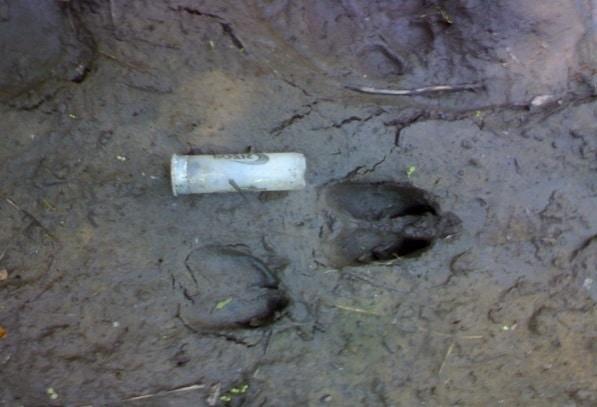
For clarity, the size of the hoof is compared with the cartridge

Footprints on soft ground are clearly visible
Once the animal's roosting sites have been located, the process can begin. You need to be there before dark, by dawn. So that the roe deer do not smell the scent of a person and are not alarmed, you need to move against the wind.
They have excellent vision and hearing, it is necessary to take care of camouflage (camouflage clothing), and move as silently as possible. The raised head of a roe deer means that it is listening; movement at this moment is not welcome. When she lowers her head to the stern, it is the ideal time to start approaching.
After approaching the distance of an accurate shot, all that remains is to get the trophy. The best places to search from the approach are:
- Feeding platforms with a tower
- Places for days and overnight stays
- Migration transition places
- watering hole
- Eating places
Illegal hunting methods
Noose for a roe deer
Hunting for roe deer with a noose is an illegal method of hunting; people who use this method are poachers. A noose on a roe deer is not only illegal, but also contrary to the principles of hunting morals and ethics. A roe deer caught in a noose cannot in any way be considered an honestly obtained hunting trophy.

A roe deer caught in a noose, by the neck or by the leg, faces a painful death; often the animal suffers for more than a day before death. A noose placed on a roe deer can get caught not only by roe deer, but also by grazing livestock that wandered into the forest in search of fresh grass, hunters participating in a driven hunt, hunting dogs that are doomed to die in the noose if the owner does not have time to quickly reach them. help, other wild animals.
The taste of the meat of a roe deer caught in a noose is much worse than the meat of a roe deer obtained in the correct way. A roe deer strangled in a noose in winter goes rotten two hours after death. In summer, the meat of a roe deer strangled with a noose begins to deteriorate even faster.
The problem is further aggravated by the fact that poachers leave their snares in the forest and forget about them. Nooses left in the forest continue to waste animals. Animals killed in the noose become food for wolves, foxes and crows.
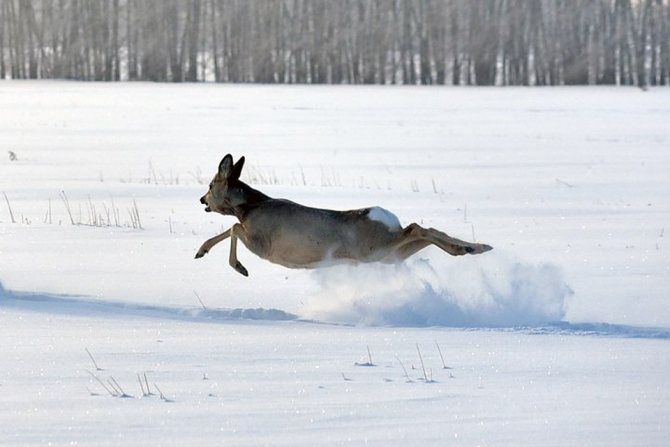
Hunting officials and game wardens are fighting poachers who install snares on roe deer, but the fight is complicated by the ease of installing snares and the difficulty of detecting the poacher.
Real, proper hunters use only legal and ethical methods of obtaining hunting trophies, and have all the necessary licenses and permits that give the right to such a hunt. Only a correctly obtained trophy can be the pride of a hunter.
Hunting for roe deer from under headlights
Hunting roe deer from under headlights is an illegal, poaching method of hunting. Poachers move around the hunting grounds in some vehicle equipped with a special search headlight, seeing the glowing eyes, illuminate the roe deer with a beam of the headlight and either immediately shoot, or if the roe deer tries to escape, they chase the roe deer in the vehicle. When being chased, a roe deer rarely leaves the headlights.
Chasing roe deer from under headlights scares away roe deer within a radius of ten kilometers or more from the hunting site.
Hunting for roe deer with a headlight involves moving around the land in a vehicle, as a result of which the surface of the ground is damaged and traces of the movement of animals are destroyed on it, which prevents proper hunters from tracking down roe deer.
With this method of hunting, wounded animals are often formed, which no one searches for and they die in vain.
Hunting under headlights carries severe penalties and is frowned upon by most hunters.
Hunting a roe deer, or hunting a roe deer with a pen
Among hunters, as well as in some literary sources, such a term is used as driven hunting, when a frightened animal is driven towards hidden shooters. The word “corral” has a specific meaning: bringing an animal to exhaustion through a long pursuit, for example, driving on crusty crust. Let's look at what pen hunting for roe deer is like.
Hunting for roe deer
The tactics of this hunt are not complicated: some of the shooters hide in ambush, in places where the roe deer is supposed to move, and some of the shooters scare away these animals from feeding or daytime and with their skillful actions (usually shouts) direct them towards the hidden shooters. The number of hunters participating can range from two hunters to a dozen or even more. But it is worth noting that with a larger group, such a hunt becomes a round-up, and it is not allowed everywhere. Also, the significant density of beaters and shooters makes it rather difficult to carry out a surge, since it is somewhat more difficult to maintain the necessary discipline and tactics, and the danger of using rifled weapons sharply increases. However, the use of smoothbore is also true, since the cartridges contain not shot, but buckshot (large) or even bullets.
When hunting by drive, the optimal group is five to six hunters, in which the ratio of shooters and beaters, depending on the terrain (light forests, roof supports), can vary in different combinations. For example, three shooters - three beaters, two shooters - four beaters, or one shooter (if the roe deer's opening is the only one and limited) - four beaters, four shooters - one beater, etc. Shooters must always have camouflage clothing, and beaters, when the participants in the hunt have not agreed to change roles, must have any clothing.
It is better to lead such a hunt by someone alone: a more experienced hunter or a huntsman who knows the area well. Otherwise, the roe deer can leave, bypassing the shooters, and with any organization of the surge. It is important to take into account the direction of the wind. Depending on the degree of caution of the roe deer, beaters should make different “noises” in different hunting grounds.
When the roe deer are calm and not frightened, then you should shout (whistle, etc.) louder, otherwise they simply may not get out of the bushes, dense undergrowth, or reeds. On the contrary, sensitive roe deer should not be overly frightened, since out of strong fear they often run anywhere, regardless of the terrain and habits. However, it also happens differently: experienced roe deer, shot more than once, make attempts in the thicket, having heard outside voices.
The person leading the hunt needs to know the nuances of the behavior of these animals in the area where the hunt is carried out.
The arrows on the “numbers” should not move to other places (even if it is really profitable), they should not talk, cough, move, or smoke. By leaving a certain place in advance, the hunter runs a high risk of being shot by a neighbor who, for some reason, did not notice his movement.
The shot is fired only at the “number”, at a clear target. Otherwise, an accident is possible, especially if there are a large number of beaters. I would like to note that the slaughter places of a roe deer, like other animals, are the head, chest, and neck. In most cases, they shoot at the shoulder blade, the most voluminous part.
Under any circumstances, the “room” is left only at the command of the leader (excluding an accident), or when the shooter sees that the beaters have already entered the “firing” line.
Roe deer hunting can be done on foot, as well as on skis and on horseback. Nowadays, transport is most often used to move around the grounds (when approaching hunting areas). And this is correct, because it takes less physical effort and also saves time.
Weapons for roe deer hunting
The roe deer is a very cautious animal, and it is quite difficult to approach it within shooting distance. In most cases, a rifled weapon gives the hunter a serious advantage when hunting roe deer.
Shotgun
A smoothbore gun allows you to hunt roe deer from a distance not exceeding 35-40 meters. If the distance to the roe deer is greater, you need to use rifled weapons.
A 12-gauge smoothbore shotgun is best suited for roe deer hunting. Smaller caliber shotguns: 16 gauge, 20 gauge, are less suitable for this type of hunting.
To hunt roe deer, many hunters use smoothbore bullets; the following types of bullets show the best results: Polev bullet, Brenneke bullet, Gualandi bullet.
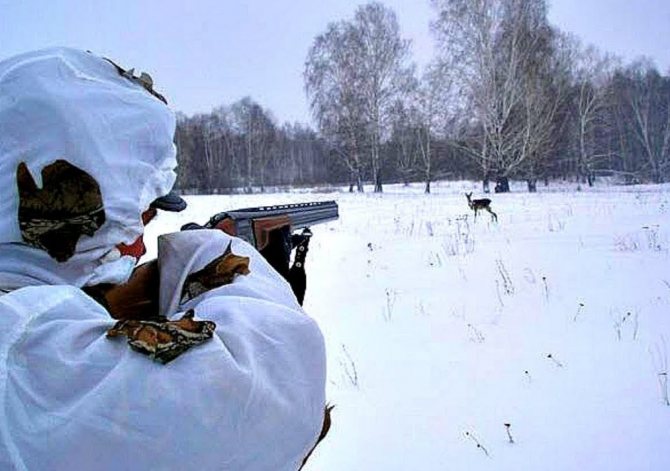
Often, when hunting roe deer, hunters use hunting cartridges loaded with buckshot. For roe deer hunting, buckshot of the following diameters is used: 5.8 mm, 6 mm, 6.2 mm, 7.5 mm.
Some hunters use cartridges loaded with 000-0000 shot when hunting roe deer.
Rifle
A rifled weapon allows you to shoot a roe deer at a distance of up to 300 meters. True, in order to make such shots, the hunter must be able to shoot accurately at such distances.
The following rifle calibers are best suited for roe deer hunting: 223Rem, 308Win, 7.62x39, 7.62x54R, .30-06 Springfield.
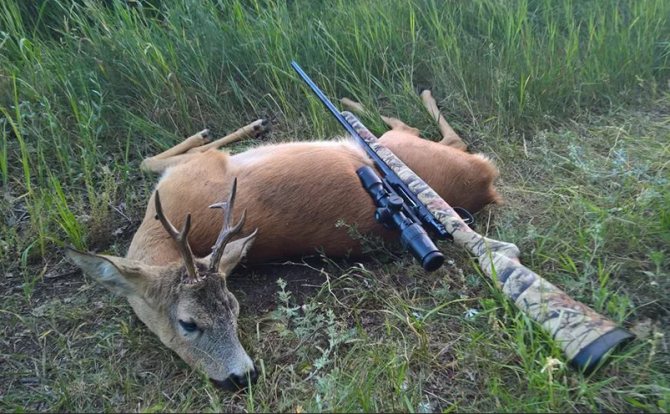
The best slaughter place for a roe deer is the neck, shoulder blade or chest. You need to aim carefully so that you don't end up wounded. Most often, wounded animals occur when shooting at an oncoming roe deer and shooting at a carjacker. It is best to search for a wounded animal that has gone far away with the help of hunting dogs trained to search for wounded animals. But it’s better to shoot so that there are no wounded animals at all.
A good option for roe deer hunting is combination guns, which combine the advantages of both smoothbore and rifled guns.
Weapons for hunting
It is difficult to get close to a roe deer, but it can still happen. Therefore, it is advisable to hunt with a gun that has a smooth and rifled barrel. If the roe deer is at a distance from you that does not exceed 30 m, use a smoothbore gun.
Shotgun
If the distance to the animal is greater, use a rifled barrel. The firing range of such a gun is 300 m. For a successful outcome, the hunter must be able to shoot accurately from a long distance.

Rifle gun
When hunting with a drive, it is better to use 12- or 16-gauge shotguns loaded with buckshot cartridges with a diameter of 6 or 7.5 mm. We wrote more about roe deer cartridges in a previous article.
To kill a roe deer outright, aim for the neck, shoulder blade or chest. The best distance to shoot at a target is 35-45 steps. If you let the roe deer get closer, you will only manage to wound the animal and it will most likely go into the forest. Wounded wounds occur when shot “on the bayonet” or in a hijack. They cannot be released from the pen. If they run far away, a specially trained dog can catch up. But it is better to avoid wounded animals. You need to shoot at the killing spots of the animal: the neck or shoulder blade. Aim carefully and get the desired prey.
Weapon
When hunting ungulates, the law recommends the use of rifled weapons with a caliber of 5 mm or larger. For roe deer, musk deer, and fallow deer, it is allowed to use smooth-bore guns with buckshot. It is more convenient to use a smoothbore gun when you can get close to the animal, but if you need to shoot from a long distance, a carbine is preferable, especially with an optical sight.

Roe deer hunting rules
Hunting for roe deer is considered one of the most difficult trades, since the animals, thanks to their keen sense of smell and hearing, notice the hunter much earlier than he does. Therefore, successful prey depends not so much on shooting skills, but on the ability to track the herd and sneak up on it unnoticed.
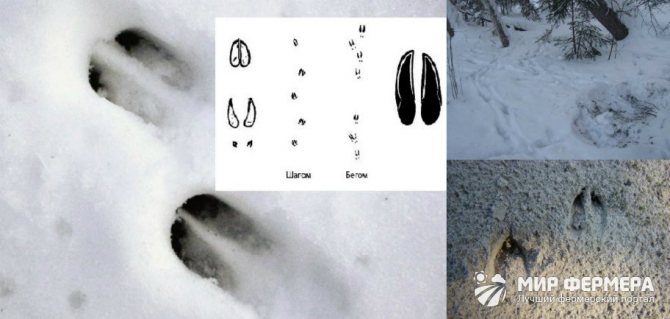
Figure 4. Animal tracks
Winter fishing is simplified by the fact that when it snows, it is much easier to notice fresh animal tracks (Figure 4). Accordingly, having certain tracker skills, the fisherman will be able to find the feeding or bedding area of the herd without any problems. It should be borne in mind that it is much easier to get close to animals in a strong wind blowing from the animals. This way you will be sure that the roe deer will not smell your scent. In addition, experienced fishermen recommend going for a trophy early in the morning, since roe deer feed either before dawn or after sunset, and the rest of the time they simply rest in holes and can be approached unnoticed.
How to track and approach
Harvesting a trophy such as roe deer can be done in two ways. The first involves direct tracking, that is, tracking down a feeding or lying area using fresh tracks. In the second case, the hunter knows in advance where the animals rest or feed, and sneaks up on the herd to shoot. Naturally, in this case, reconnaissance of the area is carried out in advance.
Whatever method you choose, you will definitely need the skills of camouflage and silent movement through the forest, because for a successful shot you need to try to get as close to the herd as possible.
To ensure a successful hunt, consider these tips:
- For fishing, it is better to choose a cloudy and windy day. Such weather conditions allow you to get close to the herd without attracting attention.
- It is better to go hunting early in the morning, so that during the day you can easily reach the animals and aim accurately.
- Be prepared for game to appear in sight at any moment, so prepare your weapons and ammunition in advance.
- It is best to start searching for game on the edges and in open forests, because this is where roe deer prefer to feed and rest.
- It is better to track not single animals, which behave more cautiously, but a whole herd at once. By gathering in groups, roe deer feel more protected.
- If you find a roe deer track, do not move straight along it, but move in a zigzag manner, periodically crossing the path at right angles. This way you will be sure that goats passing by will not smell your scent.
When examining the area, try to move extremely carefully and silently, and if you need to carefully examine the area, it is better to stop. Keep in mind that you should always approach game against the wind. This way you will be sure that animals will not smell your scent or hear the sound of random footsteps.
Particular care must be taken if you have already spotted game. It happens that while moving, a branch may accidentally crack under your feet. In this case, you should not make sudden movements, but freeze for a few minutes so that the animals calm down. You need to do the same if the roe deer turns its head towards you. Since the vision of these animals is not very sharp, she most likely caught the movement and did not notice the hunter himself.
When shooting from ambush, try not to rush and aim carefully. If the animals still sense danger, do not try to keep up with them. In most cases, roe deer will make several large jumps, and then stop and start looking around to determine the source of the noise. At this time you need to make a shot. By the way, if you managed to kill one individual, and the rest disappeared, do not be discouraged: just carefully follow the trail of the rest of the herd. Most likely, the animals will stop, waiting for a lagging relative, and you can replenish your prey.
How to shoot correctly
Roe deer are not particularly wound-resistant, but after being wounded the animal can run quite a long distance. Based on this feature, it is advisable to shoot with large shot and aim carefully, so as not to waste time tracking down the wounded animal in the future (Figure 5).
Note: The current hunting rules state that the hunter is obliged to track down and finish off the wounded animal. To do this, the fisherman has a legal day, not counting the day on which the injury was inflicted.
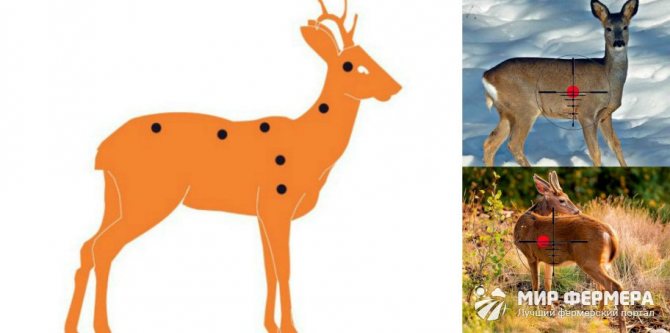
If you do not want to waste time searching for a wounded animal, it is advisable to shoot immediately in the head, neck, chest or under the front shoulder blade, where the heart and lungs are located. After such a wound, the animal will die instantly.

